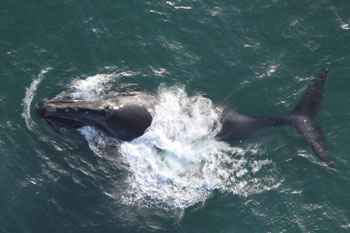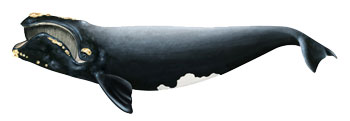More Right Whale Protections
Are Underway
by Laurie Schreiber

North Atlantic Right Whale. There is little context offered for how right whales are utilizing expanded habitats in Canadian and Mid-Atlantic waters, and how that changing range and interactions with other fisheries affects risk of entanglement. NOAA photo.
NEW YORK, N.Y.—Stronger fishing rope and northward-shifting distribution patterns are considered two factors contributing to the reduction of the endangered North Atlantic right whale population and its lower calving rates in recent years.
In a technical memorandum presented to the Atlantic States Marine Fisheries Commission (ASMFC) at its Oct. 22 meeting, Colleen Coogan, a marine mammal policy analyst with the National Oceanic and Atmospheric Administration’s Protected Resources Division, said the rise of serious injury and mortality in the population has been occurring at the same time the population appears to be changing distribution northward into the Gulf of St. Lawrence in the summer and early fall.
Also coinciding with the increasing incidence of serious injury and mortality has been the development of stronger fixed-gear ropes, she said.
“In the 10 percent of the times that we know where the whales picked up the gear, we’re seeing that entanglements can occur anywhere,” she said.
New scars are seen on about 100 whales, or about one-quarter of the population, every year, she said. That means the whales have a one in four chance of entanglement annually.
Entanglements are costly for whales in terms of the energy they spend trying to get free, she said. For females, that energy cost decreases their ability to breed.
Changing ocean conditions
appear to be contributing
to the decline, perhaps
more than fishing gear.
– Ritchie White,
ASMFC Commissioner
The southern right whale population – approximately 10,000 of them in the southern hemisphere – is an example of what a successful population looks like without fishing and shipping interaction, she said. Southern right whales can live to be over 100 years old, and they have good calving rates.
The average age of a North Atlantic adult female right whale, by contrast, is 35, she said, adding that the females don’t begin calving before age 10.
There are only about 100 adult females alive right now in the North Atlantic population of about 440. If the population decline continues at its current rate, she said, within 12 years, the gains of the past 20 years will be erased.
ASMFC commissioner Ritchie White said that changing ocean conditions appear to be contributing to the decline, perhaps more than fishing gear.
Coogan said there’s probably a cumulative impact occurring.
ASMFC commissioner Eric Reid wanted to know if the underwater noise from seismic has been analyzed as an impact on the population.
Coogan said scientists are examining noise as a factor.
Pat Keliher, vice-chairman of the ASFMC and commissioner of the Maine Department of Marine Resources, said his agency had significant concerns about the scientific merit of the technical memo.
“Any measures that we’re going to put in place to protect right whales must be based on sound science,” Keliher said. “But this memo was inconsistent in its interpretation of some of the data.”
Keliher had previously presented his concerns in an Oct. 3 letter to NEFSC.
“There is little context offered for how right whales are utilizing expanded habitats in Canadian and Mid-Atlantic waters, and how that changing range and interactions with other fisheries affects risk of entanglement,” he wrote. “Absent this information, any discussion on new regulations will be based on an incomplete picture, and provide uncertain benefit to whales.”

Overall, he wrote, the memo “is inconsistent in its application and interpretation of various data sets and publications. In some cases, conclusions directly contradict statements and information previously presented by NOAA. In several instances, the paper lacks citations or cites inappropriate sources (i.e. industry documents instead of raw data; unpublished articles) and appears to be stating conclusions or opinions without any supporting data (i.e. that the 2015 vertical line regulations are making entanglements worse).”
Most significantly, he wrote, the memo suggests that new vertical line regulations implemented in 2015 “increased the strength of rope and therefore the severity of entanglements by altering fishing practices and encouraging the use of larger diameter ropes as vertical lines. There are no current data sets or analyses used to support this theory.”
While it’s indisputable that entanglements are increasing, he wrote, a new assessment is needed in order to provide an accurate picture of current threats facing right whales. Those threats are changing rapidly, he wrote. In addition, he wrote, the memo “fails to take a comprehensive look at how entanglement rates and severity have changed since the implementation of the sinking groundline and vertical line regulations went into effect in 2009 and 2015, respectively, nor does it assess changes or trends in entangling gear during that time period. It is therefore an unreliable assessment of current regulations.”
In addition, Keliher wrote, the memo cites increased Maine landings to indicate increased effort. But landings, he wrote, “are not a proxy for effort, and have never been used as an accepted metric for increased risk of entanglement. The Memo cites Maine state landings data to demonstrate increased effort offshore without describing where the data apply in terms of fishing areas. It uses these landings to assert that there is an increased overlap and therefore level of risk ‘offshore.’” But Maine is dominated by inshore effort, he wrote.
“While the State of Maine recognizes that the size of our fishery is the reason for the focus on our impact to right whales, effective management measures will require a clear picture of changing population distribution and abundance in recent years,” he wrote. The memo points to an expanding range and increasing overlap with fisheries as sources of increased risk, while also noting decreased observations of right whales in the Gulf of Maine and Bay of Fundy during the summer and southeast coast in the winter, and an increased presence in the Gulf of St. Lawrence in the summer and off the mid-Atlantic in the winter. “Despite the changes in distribution, the only fishery considered for ‘increased’ overlap is the Gulf of Maine lobster fishery, despite the parallel assertion that the Gulf of Maine is an area of decreased presence and the fact that NOAA’s own observation resources have been diverted to Canada because of this shift,” he continued.
“(The memo) appears
to
be stating conclusions
or opinions without any supporting data.”
– Pat Keliher, Maine DMR
He concluded, “I strongly believe the Maine lobster industry takes the threats to right whales seriously and will work to identify a meaningful solution appropriate to the risk posed by their fishery under current biological and environmental conditions and considering past regulatory actions. However, conclusions based on conjecture, without sound scientific basis, will alienate their critical participation in this process. The net result of the oversimplified picture painted by this Memo is likely to be regulations imposed on a fishery or in an area that will result in very little conservation benefit for the right whale but will come at a great cost to the fishermen in terms of money, time, and safety. I look forward to working with you and your staff to improve the accuracy of the information which will inform the ALWTRT’s [Atlantic Large Whale Take Reduction Team’s] work going forward.”
According to an Oct. 15 memo from the Atlantic Large Whale Take Reduction Team, the ALWTRT met Oct. 9-12 in Providence, R.I., to review the memo, receive updates on management and enforcement activities pertinent to right whales, and review the National Marine Fishery Service’s ongoing right whale field monitoring. In addition, it reviewed proposals submitted by ALWTRT members, which included measures to reduce serious injury and mortality from entanglement.
“These proposals contained a range of management measures including gear markings, area closures, effort reductions, vertical line reductions, and gear modifications,” the Oct. 15 memo said. The ALWTRT will meet again in Mach 2019 to consider the proposals.
According to the Maine DMR’s “Proposal to Modify the Atlantic Large Whale Take Reduction Plan to Reduce Serious Injury and Mortality from Entanglement of Right Whales, Fin Whales, and Humpback Whales,” Maine “proposes a package that includes measures affecting Maine’s fixed gear fisheries to improve data on the origin of known entanglements and reduce the likelihood that a large whale encountering Maine gear will resulting a serious injury or mortality.”
In the period from 2000 to 2017, the proposal says, there were 28 confirmed entanglement cases of right whales in trap/pot or unknown fixed fishing gear. “Unfortunately, the majority of entanglement cases are of unknown spatial and/or fishery origin,” the proposal says. “Of the known cases, seven are from the U.S. and only one was confirmed in Maine lobster gear, which resulted in a successful disentanglement. Two occurred in Canadian lobster gear and 12 occurred in Canadian snow crab.” Five of the snow crab entanglements resulted in mortality a nod two in serious injury. The origin of the gear is unknown in the remaining seven cases, the proposal says.
“This data gap cripples our ability to create effective fishery regulations and provide adequate conservation benefit to right and other large whales that will impact the trajectory of these species,” the proposal says.
“Conclusions based on conjecture...will result in
very little conservation
benefit for the right whale
but will come at
a great cost to
the fishermen.”
– Pat Keliher, Maine DMR
The primary component of Maine’s proposal is to address the data gap through a more comprehensive gear marking strategy.
“Additionally, to protect large whales in those rare instances when they might become entangled in Maine gear, the second component of this proposal reduces the likelihood that interaction with Maine’s fixed gear vertical lines will result in a complex entanglement,” the proposal says. “By reducing the amount of line fished in surface systems and capping vertical line diameters, Maine will reduce the amount of line near the surface, prevent further escalation to stronger lines and reduce the strength of vertical lines in Maine.”
The goal of the latter component is to decrease the amount of line at the surface by limiting the length of line allowed between flotation devices in the surface system of Maine’ fixed fishing gear, the proposal says. Maine is exploring the possibility of requiring all Maine fixed gear fishermen subject to the Atlantic Large Whale Take Reduction Plan to decrease the amount of rope in the surface system if more than one flotation device is deployed, such as buoys, toggles, and poly balls.
“Less line at the surface will decrease the risk of encounter of that line by a large whale,” the proposal says.
Also proposed is a vertical line diameter cap. The goal is to prevent the further escalation of rope size and strength and reduce the strength of some existing vertical lines, the proposal says.
“A cap on the diameter of vertical lines would vary by distance from shore to ensure fishermen’s safety and accommodate the necessary load requirements of gear fished in deeper offshore waters versus gear fished closer to shore,” the proposal says. “This will increase the likelihood that right and other large whales break free of gear if it is encountered and reduce the number of serious injuries and mortalities.”
